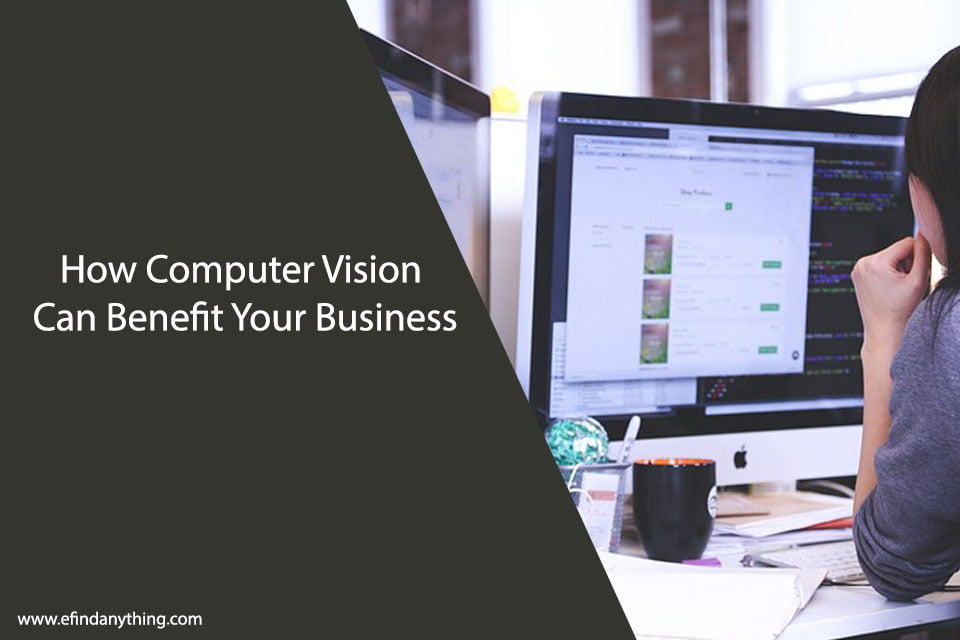Computer vision is a field of artificial intelligence that enables machines to interpret and understand the visual world. It has become increasingly popular in recent years due to its ability to extract valuable information from images and videos. In this article, we will explore how computer vision can help your business by providing insights and automating tasks.
One of the main benefits of computer vision is its ability to analyze large amounts of visual data quickly and accurately. For example, it can be used to detect defects in manufacturing processes, identify objects in images, or track the movement of people and vehicles. This can save businesses a significant amount of time and money, as it eliminates the need for manual inspection and reduces the risk of errors.
Another advantage of computer vision is its ability to provide valuable insights into customer behavior and preferences. By analyzing images and videos from social media, websites, and other sources, businesses can gain a better understanding of their target audience and tailor their marketing strategies accordingly. This can lead to increased customer engagement and higher conversion rates. Overall, computer vision has the potential to revolutionize the way businesses operate by providing unprecedented insights and automating tasks that were previously time-consuming and error-prone.

Table of Contents
Understanding Computer Vision
Computer vision is a field of artificial intelligence that enables computers to interpret and understand the visual world. It involves the use of algorithms and mathematical models to analyze and interpret images and videos, and then make decisions based on that analysis.
At its core, computer vision encompasses three pivotal steps: image acquisition, image processing, and image analysis. Image acquisition comprises capturing visual data through cameras or other sensors, while image processing focuses on refining and enhancing that data to facilitate analysis. Finally, image analysis utilizes algorithms and models to interpret the data and make decisions based on that interpretation. One significant advancement in this field is the integration of image similarity search, which enhances the ability to identify and match images based on their similarities.
One of the key benefits of computer vision is its ability to automate tasks that would otherwise require human intervention. For example, computer vision can be used to automatically detect defects in manufacturing processes, monitor traffic patterns on roads and highways, or even identify objects and people in security footage.
Overall, computer vision is a powerful tool that can help businesses in a wide variety of industries to improve their operations and increase efficiency. By leveraging the latest advances in artificial intelligence and machine learning, we can unlock new insights and capabilities that were previously impossible to achieve.
Benefits of Computer Vision for Businesses
As businesses continue to evolve in the digital age, the integration of computer vision technology has become increasingly important. Computer vision systems can help businesses improve efficiency, enhance customer experience, and reduce operational costs.
Improving Efficiency
Computer vision technology can help businesses improve efficiency by automating repetitive tasks and streamlining processes. For example, computer vision can be used to monitor production lines and identify defects in real-time, reducing the need for manual inspection. This can lead to faster production times and fewer errors.
Computer vision can also be used to automate tasks such as inventory management and object recognition. By using computer vision to track inventory, businesses can reduce the time and effort required for manual inventory management. Additionally, computer vision can be used to identify objects and their attributes, allowing businesses to quickly and accurately classify and sort products.
Enhancing Customer Experience
Computer vision technology can also be used to enhance the customer experience. For example, computer vision can be used to personalize recommendations and improve product search functionality. By analyzing customer data and behavior, computer vision can recommend products that are tailored to the customer’s preferences.
Computer vision can also be used to improve customer service. For example, computer vision can be used to monitor queues and wait times, allowing businesses to allocate resources more efficiently. Additionally, computer vision can be used to detect customer sentiment, allowing businesses to respond to customer feedback in real-time.
Reducing Operational Costs
Computer vision technology can also help businesses reduce operational costs. By automating tasks and streamlining processes, businesses can save time and reduce labor costs. Additionally, computer vision can be used to monitor energy usage and optimize resource allocation, reducing energy costs and minimizing waste.
Computer vision can also be used to improve safety and security, reducing the risk of accidents and theft. For example, computer vision can be used to monitor employee behavior and identify potential safety hazards. Additionally, computer vision can be used to monitor premises and detect unauthorized access, improving security and reducing the risk of theft.
In conclusion, computer vision technology can provide significant benefits for businesses, including improved efficiency, enhanced customer experience, and reduced operational costs. By leveraging computer vision technology, businesses can stay ahead of the competition and continue to thrive in the digital age.
Applying Computer Vision in Different Industries
Retail
Computer vision is transforming the retail industry by providing retailers with valuable insights into customer behavior. By analyzing customer data, retailers can optimize store layouts, product placement, and marketing strategies to improve customer engagement and increase sales. Computer vision also helps retailers with inventory management by providing real-time data on stock levels and product availability.
Manufacturing
Computer vision is revolutionizing the manufacturing industry by automating quality control processes. By using computer vision, manufacturers can identify defects in products and reject them before they are shipped to customers. This not only improves product quality but also helps manufacturers save time and money. Computer vision also helps manufacturers optimize production processes by providing real-time data on equipment performance and production efficiency.
Healthcare
Computer vision is transforming the healthcare industry by improving patient care and outcomes. By analyzing medical images, computer vision algorithms can help doctors and healthcare professionals diagnose diseases and conditions more accurately and quickly. Computer vision also helps healthcare professionals monitor patients and track their progress, which can lead to better treatment outcomes and improved patient satisfaction.
Transportation
Computer vision is revolutionizing the transportation industry by improving safety and efficiency. By using computer vision, transportation companies can monitor road conditions and traffic patterns in real-time, which can help drivers avoid accidents and reduce travel times. Computer vision also helps transportation companies optimize their fleets by providing data on driver behavior, fuel consumption, and vehicle performance.
Overall, computer vision is a powerful tool that can help businesses across different industries improve their operations and achieve their goals. By adopting computer vision technology, businesses can stay competitive and meet the evolving needs of their customers and stakeholders.
Challenges in Implementing Computer Vision
Implementing computer vision in your business can be a game-changer, but it also comes with its own set of challenges. In this section, we will discuss some of the challenges that businesses may face when implementing computer vision.
Data Privacy Issues
One of the biggest challenges in implementing computer vision is ensuring data privacy. With the use of cameras and other sensors, businesses can collect a massive amount of data about their customers, employees, and even the general public. This data can include personal information such as faces, license plates, and even biometric data.
To ensure data privacy, businesses must take steps to protect the data they collect. This can include implementing strict data access controls, using encryption to protect data in transit and at rest, and ensuring that data is only used for its intended purpose.
Technical Challenges
Another challenge in implementing computer vision is the technical complexity of the technology. Computer vision relies on complex algorithms and machine learning models that require significant computing power and expertise to develop and maintain. As developers strive to overcome these challenges, they can explore innovative solutions through platforms like SentiSight.ai, a machine learning platform that provides valuable resources and tools for tackling intricate computer vision tasks. One avenue to address the technical complexity is to visit SentiSight.ai machine learning platform, where professionals can leverage cutting-edge technology and resources to enhance their computer vision projects. This platform offers a robust environment for tackling the demanding aspects of algorithm development and model maintenance.
Businesses must have the technical expertise to develop and maintain these models, or they must partner with a vendor that can provide these services. Additionally, businesses must ensure that their infrastructure can support the computing power required to run these models.
In conclusion, implementing computer vision can be a powerful tool for businesses, but it comes with its own set of challenges. By addressing data privacy issues and ensuring technical expertise, businesses can successfully implement computer vision and reap the benefits it provides.
Future of Computer Vision in Business
As computer vision technology continues to advance, we can expect to see even more exciting developments in the future. Here are some potential ways that computer vision could transform the business landscape:
- Enhanced Customer Experience Computer vision can help businesses to provide a more personalized and efficient customer experience. For example, facial recognition technology can be used to identify customers as they enter a store, allowing staff to greet them by name and offer personalized recommendations based on their purchase history.
- Improved Quality Control Computer vision can be used to identify defects in products during the manufacturing process, improving quality control and reducing waste. This technology can also be used to monitor products on store shelves, ensuring that they are properly stocked and displayed.
- Increased Safety and Security Computer vision can help businesses to improve safety and security by identifying potential hazards and threats. For example, surveillance cameras equipped with computer vision technology can automatically alert security personnel to suspicious behavior or activity.
- Enhanced Data Analysis Computer vision can help businesses to gain valuable insights from visual data. For example, retailers can use computer vision to analyze customer behavior in stores, identifying patterns and trends that can inform marketing and merchandising strategies.
Overall, the future of computer vision in business is bright. As the technology continues to improve, we can expect to see even more innovative applications and use cases in the years to come.
Frequently Asked Questions
What are some examples of how computer vision can improve business operations?
Computer vision has a wide range of applications that can help businesses of all types and sizes. For example, computer vision can be used to automate quality control processes, monitor production lines, and detect defects in products. It can also be used to track inventory, analyze customer behavior, and improve security systems.
How can computer vision increase efficiency in manufacturing processes?
Computer vision can improve the efficiency of manufacturing processes by automating repetitive tasks and reducing the need for human intervention. For example, computer vision can be used to monitor production lines and detect defects in products, allowing for quick identification and correction of issues. This can help reduce waste and improve overall quality control.
What are the security benefits of implementing computer vision in business?
Computer vision can enhance security systems by providing real-time monitoring and analysis of surveillance footage. It can be used to detect unauthorized access, monitor employee behavior, and identify potential security threats. Additionally, computer vision can be used to automate access control systems, reducing the need for manual intervention and improving overall security.
How can computer vision aid in quality control for products?
Computer vision can be used to automate quality control processes, reducing the need for human intervention and improving overall accuracy. For example, computer vision can be used to detect defects in products, such as scratches or dents, and automatically reject any products that do not meet quality standards. This can help reduce waste and improve overall product quality.
What are the applications of computer vision in retail businesses?
Computer vision can be used in retail businesses to analyze customer behavior, track inventory, and improve security systems. For example, computer vision can be used to monitor customer traffic and identify areas of the store that receive the most foot traffic. This information can be used to optimize store layouts and improve overall customer experience.
How can computer vision assist in predictive maintenance for equipment in businesses?
Computer vision can be used to monitor equipment and detect potential issues before they become major problems. For example, computer vision can be used to detect wear and tear on machinery, allowing for proactive maintenance and reducing the risk of equipment failure. This can help improve overall equipment reliability and reduce maintenance costs.





